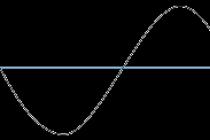Vieta's theorem (more precisely, the theorem converse theorem Vieta) allows you to reduce the time for solving quadratic equations. You just need to know how to use it. How to learn to solve quadratic equations using Vieta's theorem? This is not difficult if you think a little.
Now we will only talk about the solution of the reduced quadratic equation by Vieta's theorem. quadratic equation Is an equation in which a, that is, the coefficient in front of x², is equal to one. It is also possible to solve non-reduced quadratic equations using Vieta's theorem, but there already at least one of the roots is not an integer. It is more difficult to guess them.
The converse theorem to Vieta's theorem says: if the numbers x1 and x2 are such that
then x1 and x2 are the roots of the quadratic equation
![]()
When solving a quadratic equation according to Vieta's theorem, only 4 options are possible. If you remember the line of reasoning, you can learn to find whole roots very quickly.
I. If q is a positive number,
this means that the roots x1 and x2 are numbers of the same sign (since only when multiplying numbers with the same sign is a positive number).
I.a. If -p is a positive number, (respectively, p<0), то оба корня x1 и x2 — положительные числа (поскольку складывали числа одного знака и получили положительное число).
I.b. If -p - a negative number, (respectively, p> 0), then both roots are negative numbers (adding numbers of the same sign, got a negative number).
II. If q is negative,
this means that the roots x1 and x2 have different signs (when multiplying numbers, a negative number is obtained only if the signs of the factors are different). In this case, x1 + x2 is no longer a sum, but a difference (after all, when adding numbers with different signs we subtract the smaller from the larger). Therefore, x1 + x2 shows how much one root differs from x1 and x2, that is, how much one root is greater than the other (modulo).
II.a. If -p is a positive number, (i.e. p<0), то больший (по модулю) корень — положительное число.
II.b. If -p is negative, (p> 0), then the largest (modulo) root is a negative number.
Consider the solution of quadratic equations by Vieta's theorem using examples.
Solve the reduced quadratic equation by Vieta's theorem:
Here q = 12> 0, so the roots x1 and x2 are numbers of the same sign. Their sum is -p = 7> 0, so both roots are positive numbers. We select integers, the product of which is 12. These are 1 and 12, 2 and 6, 3 and 4. The sum is 7 for a pair of 3 and 4. So, 3 and 4 are the roots of the equation.
In this example, q = 16> 0, which means that the roots x1 and x2 are numbers of the same sign. Their sum is -p = -10<0, поэтому оба корня — отрицательные числа. Подбираем числа, произведение которых равно 16. Это 1 и 16, 2 и 8, 4 и 4. Сумма 2 и 8 равна 10, а раз нужны отрицательные числа, то искомые корни — это -2 и -8.
Here q = -15<0, что означает, что корни x1 и x2 — числа разных знаков. Поэтому 2 — это уже не их сумма, а разность, то есть числа отличаются на 2. Подбираем числа, произведение которых равно 15, отличающиеся на 2. Произведение равно 15 у 1 и 15, 3 и 5. Отличаются на 2 числа в паре 3 и 5. Поскольку -p=2>0, then the larger number is positive. So the roots are 5 and -3.
q = -36<0, значит, корни x1 и x2 имеют разные знаки. Тогда 5 — это то, насколько отличаются x1 и x2 (по модулю, то есть пока что без учета знака). Среди чисел, произведение которых равно 36: 1 и 36, 2 и 18, 3 и 12, 4 и 9 — выбираем пару, в которой числа отличаются на 5. Это 4 и 9. Осталось определить их знаки. Поскольку -p=-5<0, бОльшее число имеет знак минус. Поэтому корни данного уравнения равны -9 и 4.
In this lecture, we will get acquainted with the curious relationships between the roots of a quadratic equation and its coefficients. These relationships were first discovered by the French mathematician François Viet (1540-1603).
For example, for the equation Зx 2 - 8x - 6 = 0, without finding its roots, you can, using Vieta's theorem, immediately say that the sum of the roots is equal, and the product of the roots is
ie - 2. And for the equation x 2 - 6x + 8 = 0 we conclude: the sum of the roots is 6, the product of the roots is 8; by the way, it is not hard to guess here what the roots are equal to: 4 and 2.
Proof of Vieta's theorem. The roots x 1 and x 2 of the quadratic equation ax 2 + bx + c = 0 are found by the formulas
![]()
Where D = b 2 - 4ac is the discriminant of the equation. Having folded these roots,
get

Now we calculate the product of the roots x 1 and x 2 We have

The second relation is proved:
Comment.
Vieta's theorem is also valid in the case when the quadratic equation has one root (i.e., when D = 0), it is just that in this case it is considered that the equation has two identical roots, to which the above relations are applied.
The proven relations for the reduced quadratic equation x 2 + px + q = 0 take an especially simple form. In this case, we obtain:
x 1 = x 2 = -p, x 1 x 2 = q
those. the sum of the roots of the given quadratic equation is equal to the second coefficient, taken with the opposite sign, and the product of the roots is equal to the free term.
Using Vieta's theorem, you can get other relationships between the roots and the coefficients of the quadratic equation. Let, for example, x 1 and x 2 be the roots of the reduced quadratic equation x 2 + px + q = 0. Then

However, the main purpose of Vieta's theorem is not that it expresses some relations between the roots and the coefficients of a quadratic equation. Much more important is the fact that, using Vieta's theorem, a formula for the factorization of a square trinomial is derived, which we will not do without in what follows.

Proof. We have

Example 1... Factor the square trinomial 3x 2 - 10x + 3.
Solution. Having solved the equation Зх 2 - 10x + 3 = 0, we find the roots of the square trinomial Зх 2 - 10x + 3: х 1 = 3, х2 =.
Using Theorem 2, we obtain
It makes sense to write Zx - 1. instead of writing. Then we finally get Zx 2 - 10x + 3 = (x - 3) (3x - 1).
Note that a given square trinomial can be factorized without applying Theorem 2, using the grouping method:
Zx 2 - 10x + 3 = Zx 2 - 9x - x + 3 =
= Zx (x - 3) - (x - 3) = (x - 3) (Zx - 1).
But, as you can see, with this method, success depends on whether we can find a successful grouping or not, while with the first method, success is guaranteed.
Example 1... Reduce fraction
Solution. From the equation 2x 2 + 5x + 2 = 0 we find x 1 = - 2,

From the equation x2 - 4x - 12 = 0 we find x 1 = 6, x 2 = -2. That's why
x 2 - 4x - 12 = (x - 6) (x - (- 2)) = (x - 6) (x + 2).
Now let's cancel the given fraction:
![]()
Example 3... Factor expressions:
a) x4 + 5x 2 +6; b) 2x + -3
Solution. A) We introduce a new variable y = x 2. This will allow rewriting the given expression in the form of a square trinomial with respect to the variable y, namely, in the form у 2 + bу + 6.
Having solved the equation at 2 + bу + 6 = 0, we find the roots of the square trinomial at 2 + 5у + 6: у 1 = - 2, у 2 = -3. We now use Theorem 2; get
y 2 + 5y + 6 = (y + 2) (y + 3).
It remains to remember that y = x 2, that is, to return to the given expression. So,
x 4 + 5x 2 + 6 = (x 2 + 2) (x 2 + 3).
b) We introduce a new variable y =. This will make it possible to rewrite the given expression in the form of a square trinomial with respect to the variable y, namely in the form 2y 2 + y - 3. Solving the equation
2y 2 + y - 3 = 0, we find the roots of the square trinomial 2y 2 + y - 3:
y 1 = 1, y 2 =. Further, using Theorem 2, we obtain:
It remains to remember that y =, that is, to return to the given expression. So,
At the end of the section, there are some arguments, again connected with Vieta's theorem, or, more precisely, with the converse statement:
if the numbers x 1, x 2 are such that x 1 + x 2 = - p, x 1 x 2 = q, then these numbers are the roots of the equation
With the help of this statement, you can solve many quadratic equations orally, without using cumbersome root formulas, and also make quadratic equations with given roots. Here are some examples.
1) x 2 - 11x + 24 = 0. Here x 1 + x 2 = 11, x 1 x 2 = 24. It is easy to guess that x 1 = 8, x 2 = 3.
2) x 2 + 11x + 30 = 0. Here x 1 + x 2 = -11, x 1 x 2 = 30. It is easy to guess that x 1 = -5, x 2 = -6.
Please note: if the free term of the equation is a positive number, then both roots are either positive or negative; this is important to consider when selecting roots.
3) x 2 + x - 12 = 0. Here x 1 + x 2 = -1, x 1 x 2 = -12. It is easy to guess that x 1 = 3, x2 = -4.
Please note: if the free term of the equation is a negative number, then the roots are different in sign; this is important to consider when selecting roots.
4) 5x 2 + 17x - 22 = 0. It is easy to see that x = 1 satisfies the equation, i.e. x 1 = 1 - the root of the equation. Since x 1 x 2 = - and x 1 = 1, we get that x 2 = -.
5) x 2 - 293x + 2830 = 0. Here x 1 + x 2 = 293, x 1 x 2 = 2830. If you pay attention to the fact that 2830 = 283. 10, and 293 = 283 + 10, then it becomes clear that x 1 = 283, x 2 = 10 (and now imagine what calculations would have to be done to solve this quadratic equation using standard formulas).
6) Let's compose a quadratic equation so that its roots are the numbers x 1 = 8, x 2 = - 4. Usually, in such cases, the reduced quadratic equation x 2 + px + q = 0 is made.
We have x 1 + x 2 = -p, therefore 8 - 4 = -p, that is, p = -4. Further, x 1 x 2 = q, i.e. 8 «(- 4) = q, whence we obtain q = -32. So, p = -4, q = -32, which means that the required quadratic equation has the form x 2 -4x-32 = 0.
Vieta's theorem is often used to test roots already found. If you find the roots, you can use the formulas \ (\ begin (cases) x_1 + x_2 = -p \\ x_1 \ cdot x_2 = q \ end (cases) \) to calculate the values \ (p \) and \ (q \ ). And if they turn out to be the same as in the original equation, then the roots are found correctly.
For example, let us, using, solve the equation \ (x ^ 2 + x-56 = 0 \) and get the roots: \ (x_1 = 7 \), \ (x_2 = -8 \). Let's check if we made a mistake in the solution process. In our case \ (p = 1 \), and \ (q = -56 \). By Vieta's theorem, we have:
\ (\ begin (cases) x_1 + x_2 = -p \\ x_1 \ cdot x_2 = q \ end (cases) \) \ (\ Leftrightarrow \) \ (\ begin (cases) 7 + (- 8) = - 1 \\ 7 \ cdot (-8) = - 56 \ end (cases) \) \ (\ Leftrightarrow \) \ (\ begin (cases) -1 = -1 \\ - 56 = -56 \ end (cases) \ )
Both statements agree, which means we solved the equation correctly.
This check can be done orally. It will take 5 seconds and save you from stupid mistakes.
Vieta's converse theorem
If \ (\ begin (cases) x_1 + x_2 = -p \\ x_1 \ cdot x_2 = q \ end (cases) \), then \ (x_1 \) and \ (x_2 \) are the roots of the quadratic equation \ (x ^ 2 + px + q = 0 \).
Or, simply: if you have an equation of the form \ (x ^ 2 + px + q = 0 \), then solving the system \ (\ begin (cases) x_1 + x_2 = -p \\ x_1 \ cdot x_2 = q \ end (cases) \) you will find its roots.
Thanks to this theorem, you can quickly find the roots of the quadratic equation, especially if these roots are. This skill is important as it saves a lot of time.
Example ... Solve the equation \ (x ^ 2-5x + 6 = 0 \).
Solution
: Using Vieta's inverse theorem, we find that the roots satisfy the conditions: \ (\ begin (cases) x_1 + x_2 = 5 \\ x_1 \ cdot x_2 = 6 \ end (cases) \).
Look at the second equation of the \ (x_1 \ cdot x_2 = 6 \) system. In which two can the number \ (6 \) be decomposed? On \ (2 \) and \ (3 \), \ (6 \) and \ (1 \) or \ (- 2 \) and \ (- 3 \), and \ (- 6 \) and \ (- 1\). The first equation of the system will tell you which pair to choose: \ (x_1 + x_2 = 5 \). \ (2 \) and \ (3 \) are similar, since \ (2 + 3 = 5 \).
Answer
: \ (x_1 = 2 \), \ (x_2 = 3 \).
Examples of
... Using the inverse theorem to Vieta's theorem, find the roots of the quadratic equation:
a) \ (x ^ 2-15x + 14 = 0 \); b) \ (x ^ 2 + 3x-4 = 0 \); c) \ (x ^ 2 + 9x + 20 = 0 \); d) \ (x ^ 2-88x + 780 = 0 \).
Solution
:
a) \ (x ^ 2-15x + 14 = 0 \) - into what factors does \ (14 \) decompose? \ (2 \) and \ (7 \), \ (- 2 \) and \ (- 7 \), \ (- 1 \) and \ (- 14 \), \ (1 \) and \ (14 \ ). What pairs of numbers add up to \ (15 \)? Answer: \ (1 \) and \ (14 \).
b) \ (x ^ 2 + 3x-4 \ u003d 0 \) - into what factors does \ (- 4 \) decompose? \ (- 2 \) and \ (2 \), \ (4 \) and \ (- 1 \), \ (1 \) and \ (- 4 \). What pairs of numbers add up to \ (- 3 \)? Answer: \ (1 \) and \ (- 4 \).
c) \ (x ^ 2 + 9x + 20 = 0 \) - into what factors does \ (20 \) decompose? \ (4 \) and \ (5 \), \ (- 4 \) and \ (- 5 \), \ (2 \) and \ (10 \), \ (- 2 \) and \ (- 10 \ ), \ (- 20 \) and \ (- 1 \), \ (20 \) and \ (1 \). What pairs of numbers add up to \ (- 9 \)? Answer: \ (- 4 \) and \ (- 5 \).
d) \ (x ^ 2-88x + 780 = 0 \) - into what factors does \ (780 \) decompose? \ (390 \) and \ (2 \). Will they total \ (88 \)? No. What other factors does \ (780 \) have? \ (78 \) and \ (10 \). Will they total \ (88 \)? Yes. Answer: \ (78 \) and \ (10 \).
It is not necessary to decompose the last term into all possible factors (as in the last example). You can immediately check whether their sum gives \ (- p \).
Important! Vieta's theorem and the converse theorem only work with, that is, such that the coefficient in front of \ (x ^ 2 \) is equal to one. If we initially have a non-reduced equation, then we can make it reduced by simply dividing by the coefficient in front of \ (x ^ 2 \).
For example, let the equation \ (2x ^ 2-4x-6 = 0 \) be given and we want to use one of Vieta's theorems. But we cannot, since the coefficient in front of \ (x ^ 2 \) is \ (2 \). Let's get rid of it by dividing the whole equation by \ (2 \).
\ (2x ^ 2-4x-6 = 0 \) \ (|: 2 \)
\ (x ^ 2-2x-3 = 0 \)
Ready. Now you can use both theorems.
Answers to frequently asked questions
Question:
By Vieta's theorem, you can solve any?
Answer:
Unfortunately no. If the equation is not integers or the equation has no roots at all, then Vieta's theorem will not help. In this case, you need to use discriminant
... Fortunately, 80% of the equations in high school mathematics have whole solutions.
Any complete quadratic equation ax 2 + bx + c = 0 can be reduced to the form x 2 + (b / a) x + (c / a) = 0 if we divide each term by the coefficient a before x 2... And if we introduce new designations (b / a) = p and (c / a) = q, then we will have the equation x 2 + px + q = 0, which in mathematics is called reduced quadratic equation.
The roots of the reduced quadratic equation and coefficients p and q related. This is confirmed Vieta's theorem, named after the French mathematician François Vieta, who lived at the end of the 16th century.
Theorem... The sum of the roots of the reduced quadratic equation x 2 + px + q = 0 equal to the second coefficient p, taken with the opposite sign, and the product of the roots - to the free term q.
Let's write these ratios in the following form:
Let be x 1 and x 2 different roots of the reduced equation x 2 + px + q = 0... According to Vieta's theorem x 1 + x 2 = -p and x 1 x 2 = q.
For the proof, substitute each of the roots x 1 and x 2 into the equation. We get two correct equalities:
x 1 2 + px 1 + q = 0
x 2 2 + px 2 + q = 0
Let us subtract the second from the first equality. We get: 
x 1 2 - x 2 2 + p (x 1 - x 2) = 0
We expand the first two terms according to the formula for the difference of squares:
(x 1 - x 2) (x 1 - x 2) + p (x 1 - x 2) = 0
By assumption, the roots x 1 and x 2 are different. Therefore, we can cancel the equality by (x 1 - x 2) ≠ 0 and express p.
(x 1 + x 2) + p = 0;
(x 1 + x 2) = -p.
The first equality is proved.
To prove the second equality, we substitute into the first equation
x 1 2 + px 1 + q = 0 instead of the coefficient p an equal number - (x 1 + x 2):
x 1 2 - (x 1 + x 2) x 1 + q = 0
Transforming the left side of the equation, we get:
x 1 2 - x 2 2 - x 1 x 2 + q = 0;
x 1 x 2 = q, as required.
Vieta's theorem is good in that, even without knowing the roots of the quadratic equation, we can calculate their sum and product .
Vieta's theorem helps to determine the whole roots of the reduced quadratic equation. But for many students this causes difficulties due to the fact that they do not know a clear algorithm of action, especially if the roots of the equation have different signs.
So, the given quadratic equation has the form x 2 + px + q = 0, where x 1 and x 2 are its roots. According to Vieta's theorem, x 1 + x 2 = -p and x 1 x 2 = q.
The following conclusion can be drawn.
If there is a minus sign in front of the last term in the equation, then the roots x 1 and x 2 have different signs. In addition, the sign of the smaller root is the same as the sign of the second coefficient in the equation.
Proceeding from the fact that when adding numbers with different signs, their moduli are subtracted, and the sign of the number greater in modulus is placed in front of the result obtained, you should proceed as follows:
- determine such factors of the number q so that their difference is equal to the number p;
- put in front of the smallest of the obtained numbers the sign of the second coefficient of the equation; the second root will have the opposite sign.
Let's look at some examples.
Example 1.
Solve the equation x 2 - 2x - 15 = 0.
Solution.
Let's try to solve this equation using the rules suggested above. Then we can say for sure that this equation will have two different roots, since D = b 2 - 4ac = 4 - 4 (-15) = 64> 0.
Now, out of all the factors of 15 (1 and 15, 3 and 5), select those whose difference is 2. These will be the numbers 3 and 5. Before the lower number, put a minus sign, ie the sign of the second coefficient of the equation. Thus, we get the roots of the equation x 1 = -3 and x 2 = 5.
Answer. x 1 = -3 and x 2 = 5.
Example 2.
Solve the equation x2 + 5x - 6 = 0.
Solution.
Let us check whether the given equation has roots. To do this, we find the discriminant:
D = b 2 - 4ac = 25 + 24 = 49> 0. The equation has two different roots.
Possible factors of 6 are 2 and 3, 6 and 1. The difference is 5 for a pair of 6 and 1. In this example, the coefficient of the second term has a plus sign, so a smaller number will have the same sign. But before the second number there will be a minus sign.
Answer: x 1 = -6 and x 2 = 1.
Vieta's theorem can be written for a complete quadratic equation. So, if the quadratic equation ax 2 + bx + c = 0 has roots x 1 and x 2, then they satisfy the equalities
x 1 + x 2 = - (b / a) and x 1 x 2 = (c / a)... However, the application of this theorem to the full quadratic equation is rather problematic, since if there are roots, at least one of them is a fractional number. And it is quite difficult to work with the selection of fractions. But still, there is a way out.
Consider the complete quadratic equation ax 2 + bx + c = 0. Multiply its left and right sides by the coefficient a. The equation becomes (ax) 2 + b (ax) + ac = 0. Now we introduce a new variable, for example t = ax.
In this case, the resulting equation turns into a reduced quadratic equation of the form t 2 + bt + ac = 0, the roots of which t 1 and t 2 (if any) can be determined by Vieta's theorem.
In this case, the roots of the original quadratic equation will be
x 1 = (t 1 / a) and x 2 = (t 2 / a).
Example 3.
Solve the 15x equation2 - 11x + 2 = 0.
Solution.
We compose an auxiliary equation. Multiply each term in the equation by 15:
15 2 x 2 - 11 15x + 15 2 = 0.
We make the change t = 15x. We have:
t 2 - 11t + 30 = 0.
By Vieta's theorem, the roots of this equation will be t 1 = 5 and t 2 = 6.
Let's go back to replacing t = 15x:
5 = 15x or 6 = 15x. So x 1 = 5/15 and x 2 = 6/15. We shorten and get the final answer: x 1 = 1/3 and x 2 = 2/5.
Answer. x 1 = 1/3 and x 2 = 2/5.
To master the solution of quadratic equations using Vieta's theorem, students need to practice as much as possible. This is the secret of success.
site, with full or partial copying of the material, a link to the source is required.
When studying methods of solving second-order equations in a school algebra course, the properties of the obtained roots are considered. They are now known as Vieta's theorem. Examples of its use are given in this article.
Quadratic equation
The second order equation is the equality, which is shown in the photo below.
Here the symbols a, b, c are some numbers that are called the coefficients of the equation under consideration. To solve an equality, you need to find the values of x that make it true.
Note that since the maximum value of the power to which x is raised is two, then the number of roots in the general case is also two.
There are several ways to solve this type of equality. In this article, we will consider one of them, which involves the use of the so-called Vieta theorem.
Formulation of Vieta's theorem

At the end of the 16th century, the famous mathematician François Viet (French) noticed, analyzing the properties of the roots of various quadratic equations, that certain combinations of them satisfy specific ratios. In particular, these combinations are their product and sum.
Vieta's theorem establishes the following: the roots of the quadratic equation, when they sum, give the ratio of the coefficients of the linear to the quadratic taken with the opposite sign, and when they are multiplied, they lead to the ratio of the free term to the quadratic coefficient.
If the general form of the equation is written as shown in the photo in the previous section of the article, then mathematically this theorem can be written in the form of two equalities:
- r 2 + r 1 = -b / a;
- r 1 x r 2 = c / a.
Where r 1, r 2 is the value of the roots of the equation in question.
These two equalities can be used to solve a number of very different mathematical problems. The use of Vieta's theorem in examples with solutions is given in the following sections of the article.














